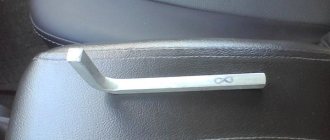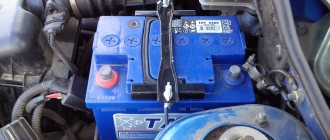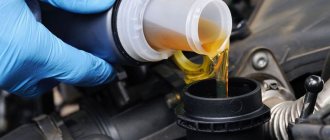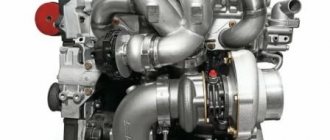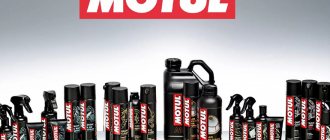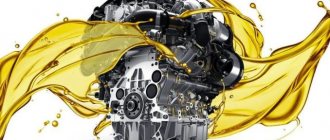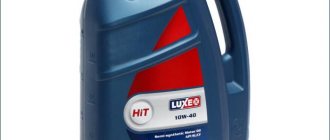The service life of the unit and the ease of starting in winter depend on what kind of oil is poured into the VAZ-2107 engine (injector). The car manufacturer recommends using mineral or semi-synthetic engine oil of API SG/CD standard with a viscosity of 5W40 or 10W40. Synthetic-based materials are used in engines that have undergone major overhauls.
Types of motor oils
To fill the engines of “classic” VAZ models with a carburetor or injection power system, the following types of lubricants are used:
- On a mineral basis with the addition of additives that reduce the wear rate of parts of the piston group and crank mechanism.
- Semi-synthetic, based on minerals with the addition of synthetic additives that reduce the rate of degradation of the material and reduce the force of friction. Recommended for cars used in winter and summer.
- Synthetic, created using the technology of hydrocracking of petroleum products.
Classification of oils
Oils are classified according to:
- type;
- viscosity;
- season;
- API criteria;
- ILSAC methodology.
There are 4 types of motor lubricant;
- mineral;
- hydrocracking;
- semi-synthetic;
- synthetic.
Viscosity is designated by grade according to the SAE system. The lower it is, the more liquid and suitable it will be for the cold season.
The seasonal classification includes:
- winter oils, which are designated by a number followed by the letter W, for example 5W;
- summer products identified only by viscosity number, for example 30;
- all-season lubricants with combined markings, for example 5W-30.
Labeling according to criteria developed by API reflects:
- applicability of the composition in a particular type of engine (products containing the letter S in their code are suitable for gasoline engines);
- performance qualities (the closer the letter is to the end of the alphabet, the higher the category the oil corresponds to).
The ILSAC methodology involves almost identical methods for assessing lubrication.
The composition class is indicated by the abbreviation GF followed by a number.
The higher it is, the better the product. Since May 2022, the GF-6 standard has come into force (corresponds to the SP marking according to the API).
In what cases is it necessary to change the oil in a VAZ-2107 engine (injector)
Engine oil needs to be changed every 8-10 thousand kilometers or annually. If traces of antifreeze are detected in the lubricant, extraordinary maintenance is carried out to check and repair engine parts. After purchasing a used car with an injection engine, it is necessary to carry out detailed diagnostics of the electronics and replace process fluids.
An additional reason for an unscheduled lubricant change is car repairs associated with disassembling the power plant (for example, when replacing crankshaft bearings).
Elimination of illiteracy
If you are interested in what kind of oil the engineers of the Volzhsky Automobile Plant recommend to fill into the power units of classic Lada cars - mineral, semi-synthetic or synthetic, then you are formulating the question incorrectly. The manufacturer's recommendations relate only to the quality standards that the engine oil being poured must meet.
Many people notice that product canisters usually have markings like API SH or API SJ/CF. You should pay attention to it first of all, since it is this marking that informs about the quality of the product.
API is an acronym for the American Petroleum Institute. This institute checks whether motor oil meets certain quality standards based on a large number of indicators, including:
- the amount of deposits remaining on engine parts after a standard period of operation;
- washing ability;
- temperature characteristics;
- toxicity;
- corrosivity;
- effectiveness of protecting engine parts from friction.
The abbreviations SJ or CF are deciphered as follows.
- S and C are the categories of engines for which the oil is intended. Lubricants for gasoline power units are designated by the letter S, and lubricants for diesel engines by the letter C.
- J and F – quality of oil performance characteristics. The farther the letter is from A in alphabetical order, the higher the product characteristics.
Engineers at the Volzhsky Automobile Plant require that the engine of the VAZ 21074 injector be filled with lubricant that at least meets the API SG/CD standard. Moreover, if you come across a product that meets the API SH, SJ or SL standard, then it is better to fill it.
Quite often, when purchasing motor oil, car enthusiasts first of all pay attention to the classification of the product according to the methodology of the US Society of Automotive Engineers (SAE). However, such a classification only determines the viscosity characteristics of the product and does not inform in any way about its quality.
Recommended VAZ 2107 oils according to SAE classification:
- Lukoil Lux – 5W40, 10W40, 15W40.
- Lukoil Super - 5W30, 5W40, 10W40, 15W40.
- Novoil-Sint – 5W30.
- Omskoil Lux – 5W30, 5W40, 10W30, 10W40, 15W40, 20W40.
- Norsi Extra – 5W30, 10W30, 5W40, 10W40, 15W40.
- Esso Ultra – 10W40.
- Esso Uniflo – 10W40, 15W40.
- Shell Helix Super – 10W40.
Which oil to choose
Short answer: it is recommended to fill the VAZ-2107 engine (injector) with mineral or semi-synthetic oil that meets the API SG/CD standard (or higher) and has a viscosity of 5W40 or 10W40. When choosing a lubricant, you should also consider the amount and type of additives. API SL and higher fluids contain special additives that reduce fuel consumption. The oils are designed for power plants with phase regulators, which leads to accelerated wear of the gas distribution mechanism parts in the VAZ-2107 engine.
Examples of mineral and semi-synthetic oils with a viscosity of 10W40 used by VAZ-2107 owners:
- "Lukoil Lux" - contains a package of imported additives.
- Shell Helix HX7 - extends the life of the power unit due to additives on mineral and synthetic bases.
- Castrol Magnatec with Dualock technology - reduces the wear rate of rubbing surfaces by 50% due to the formation of a stable film..
- BP Visco 3000 - approved by VW and Mercedes.
- Esso Ultra - designed for operation at temperatures from -25 °C.
- LIQUI MOLY Optimal - recommended by the manufacturer for engines of VAZ and GAZ cars.
The summary table shows the characteristics of popular oils for the VAZ-2107 (injector):
| Parameter | "Lukoil Lux" | Shell Helix HX7 | Castrol Magnatec | BP Visco 3000 | Esso Ultra | LIQUI MOLY Optimal |
| API class | SL | SN | SN | SL | SL | SL |
| Base number, mg KOH/g | 8,04 | 10,44 | 8,0 | 6,61 | 8,9 | 8,4 |
| Flash point, °C | 222 | 236 | 226 | 202 | 215 | 235 |
| Pour point, °C | -38 | -38 | -42 | -33 | -33 | -33 |
| Ash content, % | 1,03 | 1,23 | 1,2 | 1,00 | 1,2 | 1,5 |
In addition to mineral and semi-synthetic lubricants, there are synthetic ones obtained by hydrocracking petroleum products or natural gas. Due to the synthesis of molecules, an increase in the characteristics of the lubricant is achieved, but it is not recommended to use it in old-style engines.
Disadvantages of "synthetics":
- Increased cleaning ability, which leads to the dissolution of deposits clogging the lubricant supply channels.
- High fluidity of the substance, which is why lubricant leaks through the seals and gaskets.
- Accelerated burnout of lubricant (in worn engines) due to increased gaps.
Advantages:
- Increased fluidity - reduces the load on the battery and starter in winter when the crankshaft begins to rotate.
- The solidification temperature of the material is -50…-60 °C.
- Synthetic oil, filled into an engine that has undergone a major overhaul, speeds up the grinding-in of parts and reduces the rate of wear.
How to determine when it's time to change the oil
The lubricant in the engine needs to be updated every 15 thousand km, in the bridge - after a maximum of 40 thousand km. These recommendations are given in the owner's manual that the factory supplied with the vehicle. But they are designed taking into account the fact that at least half of the time the car will be driving on the highway. If the driver uses it only in the city and the engine constantly operates in “start-stop” mode, the specified time frame needs to be reduced by 1.5-2 times.
You can understand that it’s time to update the oil, although it has not yet reached its standard service life, by reading the pressure sensor. If they rise during a cold start and drop sharply after warming up, this is a signal that the lubricant has lost its properties.
Step-by-step instructions for changing the oil
Preparation for servicing consists of warming up the engine with a trip of 10-15 km. Maintenance is carried out on a platform or lift; to perform the work, a key and a container for collecting waste are required.
Algorithm of actions:
- Unscrew the drain plug with a key and place the container.
- Wait 10-15 minutes and then put the plug back in place.
- Replace filter
- Pour lubricant into the crankcase using a funnel. The amount of liquid filled is checked with a metal dipstick.
- Close the filler cap and then start the engine.
- Stop the engine after 1-2 minutes and then check the lubricant level. If necessary, add fluid.
- Make sure there are no leaks through the drain plug, front seal and filter fitting.
- Reinstall the pan protection.
Methods for determining the need for replacement, filling volumes and expert advice
If an oil pressure sensor is installed on the engine of your car, this makes it much easier to determine the moment after which a scheduled lubricant change is required in the VAZ 2107 engine. To determine the exact moment, you need to pay attention to the lubricant pressure in different operating ranges of the power unit. Usually, when the lubricant decomposes, the VAZ 2107 oil pressure indicator (installed on all cars produced before 1988) shows an increase in pressure in the system during startup and long-term operation of the power unit.
This happens due to liquefaction and boiling of the lubricant in the crankcase of the power unit. If there is no oil pressure sensor on your car, then you will have to rely on the recommendations of the car manufacturer. AvtoVAZ engineers advise changing the lubricant in the engine every 6,000 km when driving short distances and every 10,000 km when driving constantly over long distances.
Many owners of classic cars are interested in the question of how much oil should be poured into the lubrication system of the power unit of their favorite car. According to the manufacturer, the volume of engine oil in the engine lubrication system is about 4 liters, or more precisely, 3750 milliliters, including lubricant in the filter. Expert advice.
- When changing oil, it is better to fill in the brand that was poured into the engine crankcase before.
- It is not recommended to fill old power units with synthetics, since it washes out deposits covering microcracks in the oil sump.
- It is better to immediately fill a new factory engine that has been run-in with synthetics. In a good engine, synthetics are welcome; they will prevent it from overheating and extend its service life.
Regardless of how much your car has driven, if you change consumables and operating fluids on time, your car will delight you with its reliability for many years.
The VAZ 2107 car was produced in our country for almost 30 years, from 1982 to 2012. From the very beginning of production, it was positioned as a luxury version of the VAZ 2105 with a more powerful and reliable engine. In addition, this classic sedan was equipped with a more comfortable interior with comfortable front seats, a redesigned instrument panel, and a slightly more presentable appearance with more chrome in the trim elements.
Many VAZ 2107 cars were equipped with 1.5-liter carburetor engines producing 77 hp. Cars produced after 2000 were equipped with VAZ 21067 injection engines.
Many owners of these cars are interested in what kind of oil to pour into the VAZ 2107 injector or carburetor. To extend the life of the engine, it is important to change the oil regularly, and experts note that both injection and carburetor engines can be filled with the same lubricant.
Tips and tricks from professionals
When changing the oil, it is recommended to use the same type of lubricant as before. Motor lubricants based on different bases are compatible; engine flushing is not required. During operation, it is necessary to promptly change the engine oil. Lubricants to be filled must meet the requirements of the vehicle manufacturer. It is also recommended to check the fluid level in the crankcase before each trip and top up the lubricant to the normal level.
Previous
Average volume of oil in the gearbox of a VAZ 2114
Next
Step-by-step instructions for changing transmission oil in a VAZ 2110 gearbox
Advice from professionals
Experienced auto mechanics recommend choosing a product of the brand that is already in the engine. They must at least match in type, class and viscosity. If you plan to change any of these parameters, you need to not just drain the old lubricant, but thoroughly flush the engine.
You should not dramatically increase the quality of the lubricant. If you bought a used car whose previous owner used mineral products, it is recommended that you continue to use similar mixtures. The older the car, the more strictly this rule should be observed.
The second important point: compositions with enhanced cleaning properties should not be used for old cars. This will remove many years of deposits, which will cause knocking. You can often find advice to avoid synthetic oils, despite the fact that they are optimal for climatic conditions. How true is this recommendation (in your experience)?
- Oil for VAZ 2114
- Oil additives
- Which car air conditioner cleaner is better?
- The best 5w40 synthetic oil
- Autocompressor rating of the best
- What kind of oil to fill in a Priora 16 valve engine
- Lada Vesta oil
VAZ 2107 oil: important recommendations for its selection
Good day, dear readers of the blog, who also happen to be the happy owners of a vehicle. Today we will pay attention to the owners of Zhiguli. There is only one question on the agenda: what kind of oil is needed for the VAZ 2107, as well as the frequency of its replacement.
When might you need an oil change?
Let's start by looking at the power units in various modifications of this car. In the old days, the “seven” was equipped with a 1.5 liter carburetor engine. Since 2000, it was possible to find a car with a VAZ 21067 injection engine on sale. Zhiguli owners, like no one else, know very well that for long-term operation of the engine it is necessary to change the oil regularly, and how much oil and how often to change it, we will consider further . A pressure sensor will help us with this, which automatically analyzes the volume of oil inside all engine systems in various temperature ranges of its operation. As soon as it becomes necessary to change the oil or top it up, the owner will be notified of this by a light indicator on the dashboard. This may happen for the following reasons:
- dilution of the lubricant mixture
- squeezing it out through connecting hoses, pipes, etc.
- loss due to loose clamps
- engine head gasket wear and much more
In addition to the fact that you need to monitor the oil level, you need to understand that it loses its characteristics during operation. The standard recommendation is to replace the lubricant every 10 thousand kilometers traveled. In cases where the car is not used regularly, replacement must be done every 6 thousand km.
Which lubricant to choose
The circle of experienced Seven car owners has collected a lot of practical data on the topic of when to change the engine oil and what it should be like:
- mineral. It was the only solution for decades, but fewer and fewer Zhiguli owners are currently using it. If frost sets in above minus 20, starting the car becomes very problematic. That is, you have to forcibly dilute the lubricant by heating in order to be able to turn the crankshaft with the starter
- synthetic and semi-synthetic. The best choice for this machine. By all criteria, such products are better than mineral ones. It provides better lubrication of rubbing parts and components, allowing you to extend the service life of the motor. Even at a temperature of -30 degrees or more, there will be no problems with starting. Despite the frost, the starter can start the engine even on the first try if there is a well-charged battery.
To understand how many liters you will need to purchase in the store, you should know the volume of the entire engine lubrication system. According to the instructions, the exact capacity is 3.75 liters, so you will have to buy at least 4 liters. The traditional capacity of most types of motor oils is 5 liters in one canister (if purchased not on tap). It is better to use the remainder for periodic topping up.
The lower the temperature of the engine oil, the thicker it is and the more difficult it will be to start the engine. It is these indicators from SAE, the American Association of Automotive Engineers, that formed the basis for traditional labeling, for example, 10W-30, 5W-40, and so on. These numbers and letters indicate the viscosity and other performance properties of the lubricating fluid.
The letter W itself indicates that the oil can be used in the winter season. The first number in front of it indicates what temperature it can withstand. As for the second number, it is a display of high-temperature viscosity, that is, it shows how many degrees the oil will withstand in the summer heat without changing its qualities.
In fact, the number before W should not be understood as a literal temperature tolerance for operation. If it’s 10, it means the permissible temperature is 20–25 degrees below zero. 15W oil is designed for minus 15–20 C°. The lower the value, the thinner the lubricant is. For example, one of the most versatile 10W30 is used from minus 25 to + 25 degrees Celsius.
If you take the advice of AvtoVAZ, then you should make a choice in favor of such manufacturers as Esso, Shell, Lukoil, Norsey Extra, Novoil. In addition, it is useful to adhere to the following general recommendations:
- it is advisable to use the exact type and modification of lubricant that was poured earlier
- For old, worn-out carburetor-type engines, mineral lubricant is quite suitable, since it does not erode deposits that cover microcracks in the engine
- new engines, and especially the injector, require synthetic oil. It prevents overheating of the power unit and extends its service life.
Timely replacement of lubricant in the VAZ 2107 will help avoid more expensive repairs and replacement of spare parts, regardless of its mileage. Subscribe to our blog updates, and in the future you will be able to keep abreast of the main innovations in the automotive industry. See you!
Author:Andrey
avto-kul.ru
Why do you need to change the oil?
As you know, the engine is the heart of any car. And the heart cannot function without blood. In this case, the blood is motor oil, which lubricates moving parts and also cools various components in the engine.
Over time, such a lubricant loses its characteristics, becomes dirty and cannot effectively cool the engine, which leads to various serious breakdowns. To prevent such problems with the engine, the VAZ 2107 oil change should be carried out every 15 thousand kilometers. Moreover, if the car is used in the city, it is best to reduce the service interval to 10,000 miles.
Engine oil and its types
The operating instructions contain information regarding a possible list of recommended oils, which are intended for injection and carburetor engines. To understand, you should distinguish between two types of oil: mineral and synthetic.
Mineral oil, as a rule, can leave negative memories for the owner regarding its use in the winter. The VAZ 2107 is very difficult to start at temperatures above twenty degrees below zero. In such a situation, you need to heat the substance in a special way so that it becomes less thick. In other weather conditions, no disadvantages are felt. Therefore, you can use mineral oils, but you need to know their characteristics. If the car owner operates the car most of the time in difficult weather conditions, or in winter the temperature regularly drops below twenty degrees, it is better to abandon this type of oil.
Synthetic oil. This type can safely include both semi-synthetic substances and full synthetics. As reviews from car enthusiasts show, these types of oil have better parameters compared to mineral substances. Thanks to their properties, they lubricate parts better. This mainly occurs due to the addition of additives. With regular use, there is less engine wear. The temperature for using oil is quite high in winter. This makes it possible to operate the VAZ 2107 car in difficult weather conditions, at high sub-zero temperatures.
Domestic car maintenance: replacing lubricant
And a little about the author’s secrets
My life is not only connected with cars, but with repairs and maintenance. But I also have hobbies like all men. My hobby is fishing.
I started a personal blog in which I share my experience. I try a lot of things, different methods and methods to increase my catch. If interested, you can read it. Nothing extra, just my personal experience.
Attention, TODAY only!
“Seven” from VAZ is one of the longest-living record holders in our automobile industry. Since the release of the first copy in 1982, it has not left the assembly line for 30 years. The model was positioned as a luxury version of the VAZ 2105 with a more powerful engine. Otherwise, the “seven” was distinguished by comfortable seats, a redesigned dashboard and a lot of chrome in the trim. Until 2000, the VAZ 2107 was equipped with a 1.5-liter carburetor engine, after which it was equipped with injection units of the same volume.
Engine life depends greatly on the quality and type of oil used. What kind of oil to fill in VAZ 2107
? The simple answer to this question is simple: “You must use the oil recommended by the manufacturer.” But this issue deserves more detailed consideration.
When to change and how much oil to pour into the engine
The oil change on the injection VAZ 2107 is carried out in the same way as on the carburetor, i.e. every 10,000 km.
At the same time as changing the oil, the oil filter is also changed.
According to the instructions, you need to fill the car with 3.75 liters
oils But as practice shows, 4.0 liters will need to be poured into the oil filler neck, and the initial oil level will be close to the “MAX” value on the dipstick.
If the oil is changed in the cold season, then its level should be only slightly higher than o. This will allow the engine to warm up faster. In hot weather, on the contrary, the oil level should be at about. Since the volume of pumped oil in the system will increase, this will have a beneficial effect on the temperature in the engine as a whole.
Motor oil and other oils poured into the VAZ-2107 - how to choose the right one
Oil used to lubricate internal combustion engines operates under very difficult conditions. Multi-ton loads, high pressure, aggressive vapors of various liquids, temperature changes - all this affects the oil and changes its properties. Therefore, even the most modern motor oils have a limited service life. The VAZ instructions determine the oil change period at 10,000 km or 6 months. It depends on what comes first. It is not advisable to deviate from this deadline. During this mileage, the oil absorbs a huge amount of contaminants, and additives lose their properties. This black slurry looks more like paint than oil and, with its entire appearance, says “replace me.” The oils poured into the gearbox and rear axle housing have a slightly different composition and properties. It is more important for them to have high lubricating properties and the ability to withstand high specific loads. Therefore, such oils, and they are called transmission oils, have a higher viscosity - 75W90, 80W90 according to SAE. According to the instructions, they are supposed to be changed after 60,000 km. The same oil is filled into the steering gear housing; it is not recommended to change it, but it is better to play it safe and fill it with fresh oil.
Which oil to choose for VAZ-2107
For motor oil , the first thing to consider is the vehicle's total mileage . If it is not very large (less than 60,000 km), we choose a lower viscosity 5W30, 10W30 according to SAE. “Older” engines, with wear close to the limit, require high-viscosity oil 15W40, 20W40. Also, different companies have brands for worn-out engines. They contain special additives that increase compression, reduce noise, and reduce oil consumption. Why not pour such oils into all engines? Because, due to their high viscosity, they are more difficult to pump through channels, gaps and holes with an oil pump, leading to energy losses. As a result, fuel consumption increases and power decreases, not by much, but it increases. Owners of worn-out VAZ-2107 have to put up with this, so they “pay” for deferring major repairs.
Today oils of three main compositions are produced and sold: -mineral; -semi-synthetic; -synthetic. In addition, in each of these groups there are brands “simpler and cheaper” and “cooler and more expensive”. Their properties can differ greatly. Therefore, when buying a used Seven, ask the previous owner what kind of oil he used and try to stick to the same brand and quality. After all, if you suddenly change the quality of the oil, you can “kill” the engine. How? And here it is: the previous owner filled it with inexpensive “semi-synthetic” oil, and you decided to please your “swallow” with expensive branded synthetic oil. Before adding fresh oil, the engine was washed, and fresh, expensive oil has much more effective cleaning properties. All accumulated deposits were washed away, the gaps in the joints increased, the pressure decreased sharply and the engine “knocked”. But if you filled in expensive oil, and you don’t want to spend that kind of money, then you can safely fill in cheaper oil. It is only desirable to have the same composition and viscosity.
The second selection condition is the place of residence of the car
Although the oils are all-season, differences in the climatic conditions of the Krasnodar Territory and Vorkuta (for example) force an adjustment to be made for the viscosity of the oil being poured. Cold climate 0W30, 5W30, warm climate 5W40, 10W40. If all conditions are met and there are no “contraindications”, then synthetic oil is the best that is on the market. “Mineral water” and “semi-synthetic” manage to compete with it only because of their low price.
Choose a manufacturer so as not to end up with a fake. It is best to purchase oil in branded stores. The same goes for the oil filter.
Transmission oils
Everything is simpler here; if the oil seals and gaskets are in good condition, then it is better to fill in with synthetic gear oil. With it, in the cold season the car drives easier and consumes less fuel.
How much oil do I need?
Engine lubrication system – 3.75 l; Gearbox housing – 1.35 l; Rear axle housing – 1.3 l; Steering gear housing - 0.215 l
Criterias of choice
When choosing motor oil, every motorist tries to find the optimal balance between price and quality. After all, when buying frankly cheap lubricants, everyone understands what the operation of a car with such a lubricant can lead to. But not everyone is ready to spend money on too expensive compounds. To select the correct motor fluid, it is important to know the basic data of your VAZ-2106. This information includes:
Which manufacturer to choose
In the 2022 market there is an abundance of manufacturers whose products are suitable for filling in the VAZ 2101. Among the many brands, the following stand out.
- Lukoil. A domestic company, which is a proven manufacturer specializing in the production of budget oils. The brand’s liquids have proven themselves to be excellent among a wide range of motorists as cheap and fairly effective lubricants. The disadvantage of lubricants is their short service life and inability to work under critical overloads.
- Castrol. The next popular brand. The manufacturer is in demand among domestic drivers due to its optimal cost, long service life and wide distribution in stores.
- Rosneft is another Russian company. Manufacturer's lubricants are less popular, but also provide good engine protection against wear and early aging.
- Shell. Some car enthusiasts prefer the company's oils due to the increased performance of the fluid. Lubricants cope well with overloads, extended service intervals, and severe temperature changes. Disadvantages include increased cost and low availability in regular stores.
